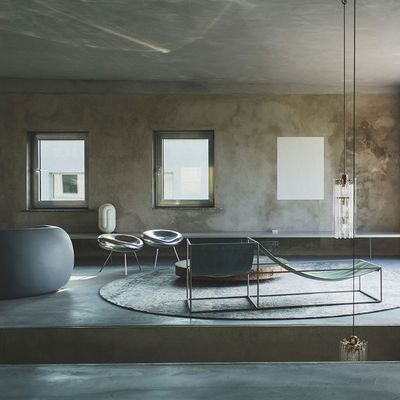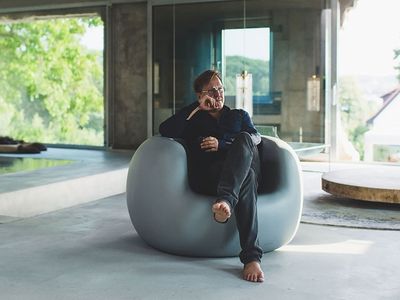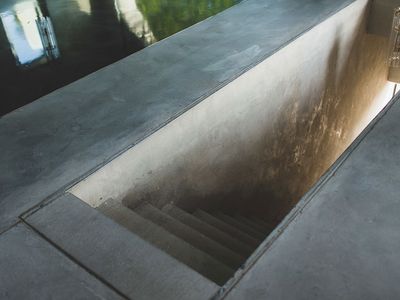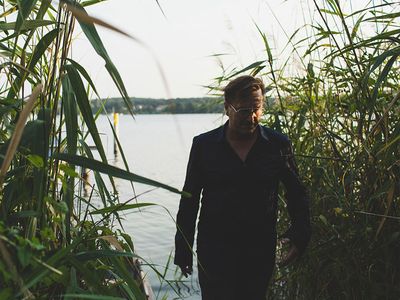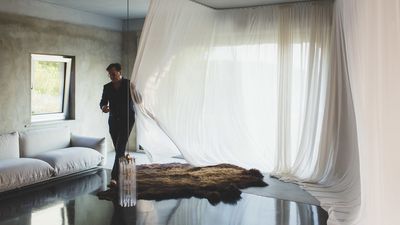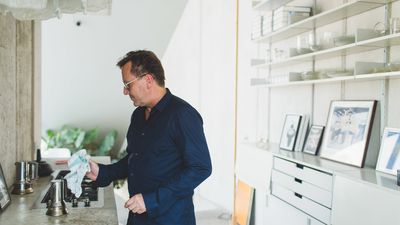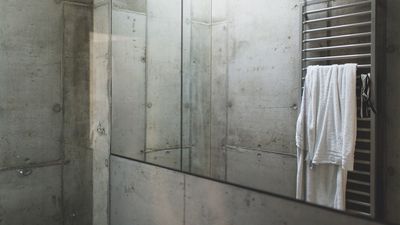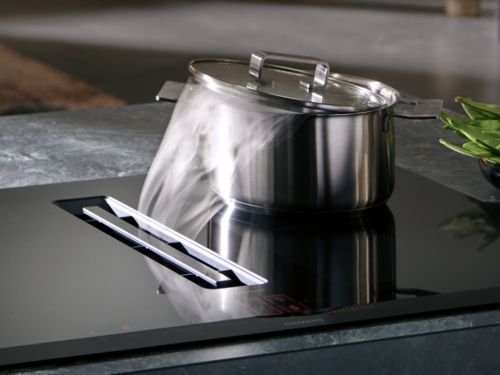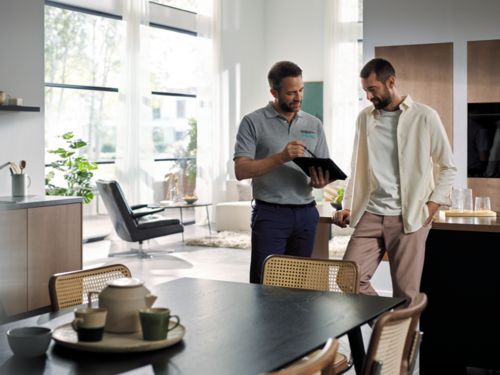Arno Brandlhuber – Architect, Apartment & Antivilla, Berlin & Potsdam (Germany)
This motto is working out for Arno Brandlhuber. As an architect, he lives and works in one of his own creations, 0113 at Brunnenstrasse in Berlin. Behind walls made of polycarbonate, the space serves as a meeting spot for city artists and creatives. The uneven concrete staircase in the courtyard wiggles up four stories to a gallery, a publishing company, and then to Arno’s office. At the very top is his apartment. None of this existed prior to 2009 - only the basement and elevator foundation.
Instead of using the elevator, Arno arrives on foot today. He wipes his hair from his forehead and starts making himself some coffee in the open kitchen. Everything up here is open. The only door leads to the bathroom - there isn’t much else that’s private. Yet the apartment is inhabited. Because even though Arno works up here as well, it is not a showroom. It is what it is, says the architect – and that can change according to mood or need.
The same is true of the Antivilla, the former factory in Krampnitz near Potsdam with which Arno is currently causing a stir. This is due to its sustainable energy concept - and also to its innovative windows, which Arno and his friends carved out with a sledgehammer. They are bigger now, and make for an even better view of the lake – a detail that’s as important to the architect as cost-effective building methods.
"You fall in love for the first time with somebody that might be in love for the first time, as well. You dream about this all your life – and you never experience it again. Construction projects are similar."
What makes reuse better than new construction?
Sometimes in puberty, you fall in love for the first time with somebody that might be in love for the first time, as well. You dream about this all your life - and you never experience it again. Construction projects are similar. Most of it already has a use, an application, a feel. You should redesign it instead of tearing it down.
A key term for you is cost-effective building. What do amateurs have to consider here?
When you do everything right, you won’t build cost-effectively. But when you want to do even more things right, you could say that some standards are simply not necessary. For example, the floor here. It is simple, smoothed concrete. Compared to shell construction, that’s a premium of five Euros. If you want, you can add a Persian rug and embellish the concrete as desired.
Aside from Persian rugs, what are other good ways to finish the material?
I don’t have a favorite finish. But of course, there have been a few experiences with situations that have quite a bit of visible concrete. For example, in South America. They usually come with a slab of wood – much like here at Brunnenstrasse. Add a few large-leaf plants, and it works. Maybe it’s time to comment on the general fear in Germany, the strange discomfort when it comes to concrete. It probably comes from the residential developments of the late 50s and particularly the 60s. Something got stuck there. And the social rigor associated with these large housing developments is often associated with concrete as a building material, as well. But by now this has largely dissipated. I don’t think there is anyone left that sees concrete any differently from wood or plastic or glass. But since we are so seldom inclined to look toward the future and are obsessed with the past instead, we are still talking about concrete as a bad component.
What do you personally like so much about concrete?
It is one of the best materials ever: First of all, it is soft, then it gets warm when it sets. It can take on any shape - it has no direction initially. And finally, it becomes whatever you want it to become. It can be a floor, it can be a beam, it can be a kitchen countertop. And that makes it interesting to me. Concrete is one of the few materials that can be shaped in such a way.
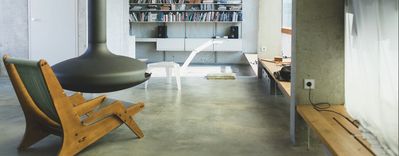
"It [concrete] is one of the best materials ever: First of all, it is soft, then it gets warm when it sets. It can take on any shape - it has no direction initially."
How much time do you spend out in Krampnitz?
I’m on the road a lot, probably half of the year. And for this reason I'm always really glad to be here at Brunnenstrasse! As for Krampnitz – I have to say, spending the summer with lake access is excellent. And there, as is the case here, the use of the space is not formalized. Multiple uses are possible and desirable. The Antivilla is my studio - events and symposiums are held there, but overnight stays happen, as well.
Would you have taken on the project if it hadn’t been located near a lake?
No. What would I want there? It’s wonderful to start the day with swimming. It’s so energizing - other rituals such as a double espresso or a cold shower are nothing in comparison. I go swimming in the morning, work for two hours. And in those two hours, I accomplish half a day’s work.
Even so, I think that the city or cities provide the greatest way of life – because they can integrate such diverse ways of life. In this respect, I believe that everything should be focused on cities, or on the areas surrounding cities. In those areas, you will find a lot of constructions.
For example the Antivilla. How did you originally come to it?
Similarly to the house at Brunnenstrasse: there was a plot that was offered that already contained something, in this case an old textile factory. The plot was offered for a 350 square foot single family home. But it already contained a 1,600 foot building. Imagine this. You pay the land price for a single family home, plus the demolition costs - instead of just using the existing property. That way you have twice the gains. No demolition costs and a building shell. And instead of an allowance of 350 square feet, you have 1,600 square feet to reuse. And if you accounted for the energy that has been put into an existing house, you would spend much less on insulation. And the overall energy result would suggest that old buildings are privileged, first and foremost. In this respect this is a model to be widely applied.
Instead, you initially received criticism from the neighborhood around the Antivilla. How do you handle such things?
Oh, that’s not just the case for the Antivilla. The Cultural Senate of Berlin sits across the street from us here at Brunnenstrasse. Their nickname for the building: the garage - because we have used a lot of polycarbonate here. So if we imagine that we are not just following an already existing idea of a beautiful building, and that we are developing the building based on very specific choices that are consistent with each other, then you end up with a totally different picture. Then the picture is initially unknown. And we know that anything unknown can easily cause alienation. That’s what happened here and also in Krampnitz.
Of course, the Antivilla starts out amazing the neighbors. And there are other factors at play, for example that many people used to work in the factory there. Many lost their jobs. So the expectations of whomever turned the factory into something new was pretty negative from the outset. But since then it has come to the point where bike tours now use it as a destination, announcing with a megaphone, “This is the Antivilla that you have been reading about.” And meanwhile, ladies from the town are starting to arrive with baskets bringing apples and nuts. It’s just a process you have to go through when you’re new in town. I think it’s relatively normal.
And you have brought a lot with you: You are always surrounded by colleagues, artists, creatives. How do you inspire each other?
It’s very simple. If you ask a fruit grower a question, he answers with a fruit. If you ask an architect a question, he answers with a building - and that’s true for many visual artists. When I am spending time with other creatives, they always answer from different perspectives. And only that way am I able to imprint something into an existing property or environment.
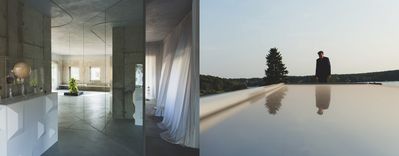
When you look at this development and the finished Antivilla now, do you feel proud?
It’s two-sided. On the one hand, I have gotten a certain amount of attention for it. On the other hand, the affordable rent of our house wasn’t able to bring down other rents in the area. For that to happen we would have to keep building. The economics of attention are rather counterproductive sometimes. Either way, I believe that as an architect you have to be able to arrive somewhere.
Do you get the sense that you have arrived?
Berlin has received me extremely well. It is not a given that I will go to a city and that the city will be this open. But I believe that Berlin has a very specific dialogical quality. Fortunately, everything is ambiguous here. There is much juxtaposition that makes this city particularly productive and creative.
Is architecture just a creative outlet for you, or is it also an art form?
There is this old myth about architecture being the mother of all art forms. But I think that the production environments are completely different. Contrary to other art forms, architecture usually involves a client and is very dependent on marketing. We often have to market buildings first, before we even get the contract assigned. This is a problem because it takes me a pretty long time before I know what a building will look like. I think that this layering of external circumstances makes architecture perhaps a bit more like playing chess.
Why do you like having art around you?
These pieces of art are mainly trade objects. And because everything comes from a trade, I must have, at some point, been interested in a question that an artist directed at me. That is often sufficient, even in the long run.
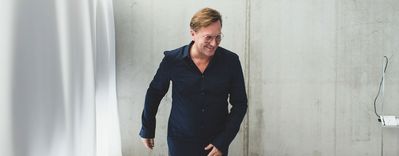
Dear Arno Brandlhuber, thank you very much for this beautiful conversation.
For more about Arno Brandlhuber and his work check out his website.

